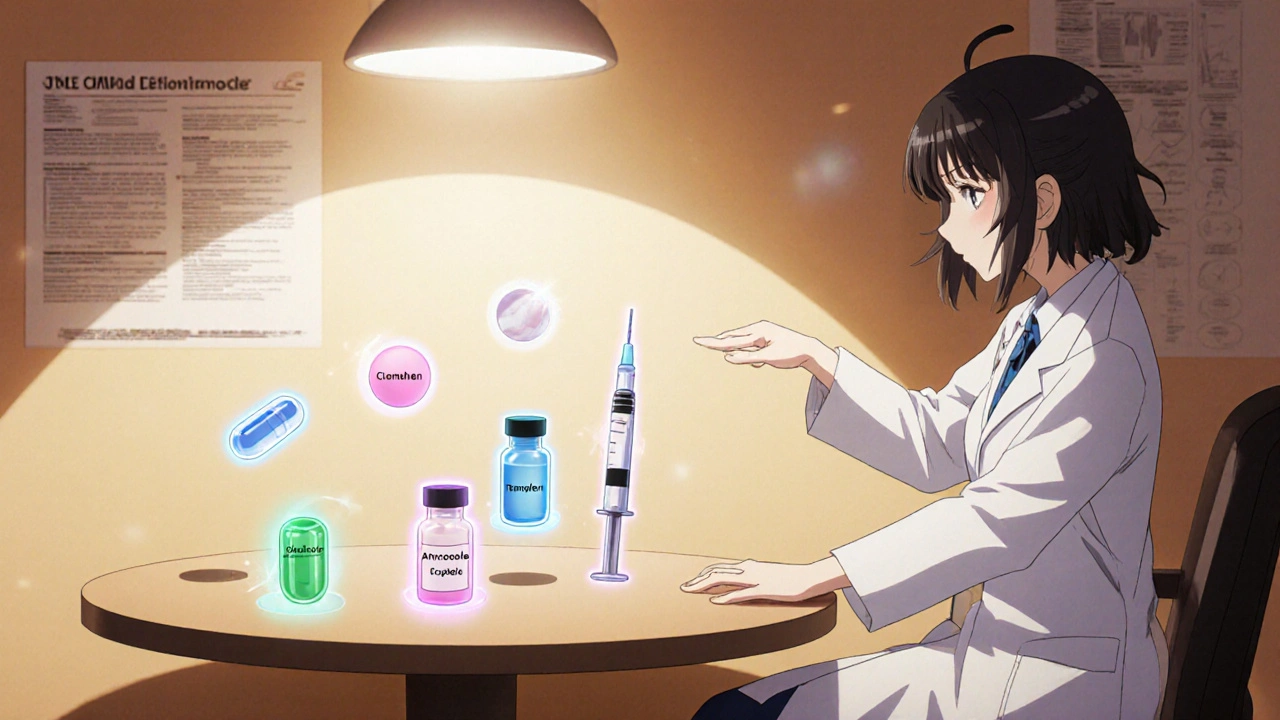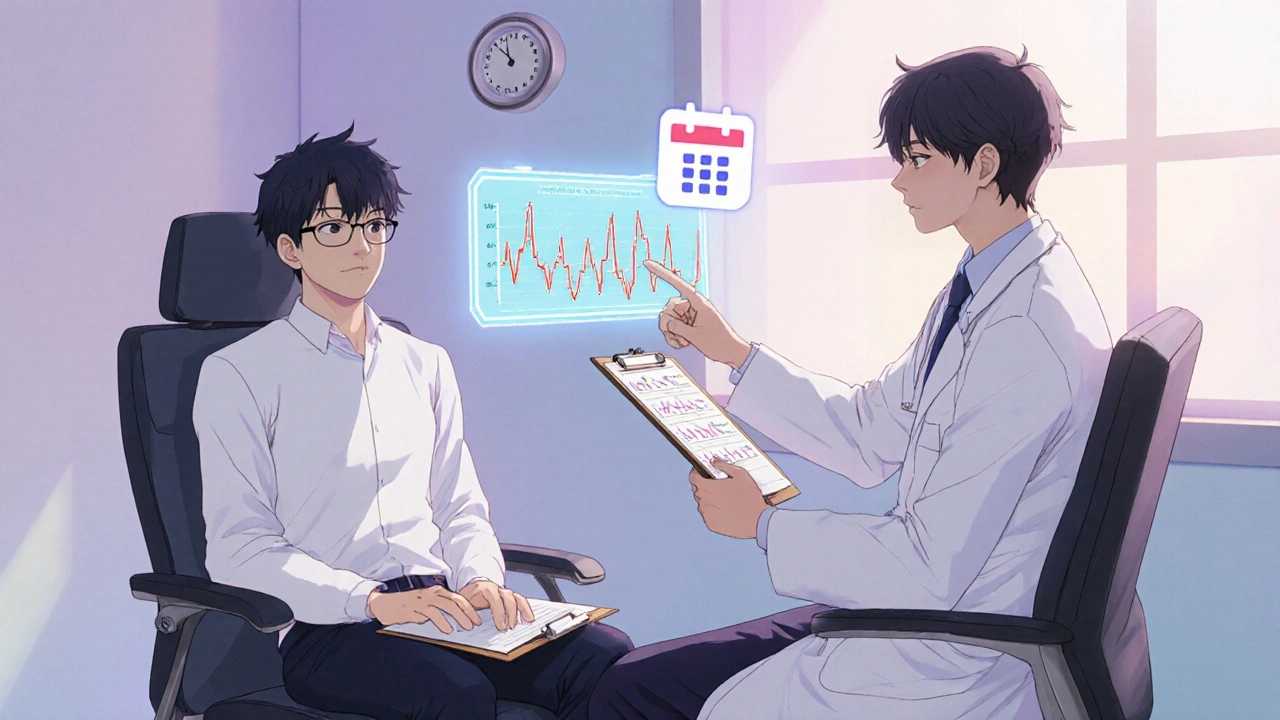Testosterone Treatment Comparison Tool
What's your main goal?
Your selected criteria
Treatment Recommendations
Select your main goal to see personalized recommendations
When it comes to boosting low testosterone or improving male fertility, Enclomisign often shows up in the conversation. But it’s not the only option on the shelf. This guide walks you through what Enclomisign (enclomiphene) actually does, how it stacks up against other drugs, and which one might fit your needs best.
What is Enclomisign (Enclomiphene)?
Enclomisign is the brand name for enclomiphene, a selective estrogen receptor modulator (SERM) that isolates the trans‑isomer of clomiphene citrate. It was originally developed to treat male hypogonadism by stimulating the body’s own testosterone production without the need for external hormone replacement.
How Enclomiphene Works
Enclomiphene blocks estrogen receptors in the hypothalamus, tricking the brain into thinking estrogen levels are low. This triggers the release of gonadotropin‑releasing hormone (GnRH), which in turn boosts luteinizing hormone (LH) and follicle‑stimulating hormone (FSH). The rise in LH signals the testes to crank out more testosterone, while FSH supports sperm production. Typical oral doses range from 12.5mg to 25mg daily, with a half‑life of roughly 30hours, allowing once‑daily dosing.
Key Attributes of Enclomisign
- Drug class: SERM (selective estrogen receptor modulator)
- FDA status (U.S.): Not approved as a prescription medication; available in clinical trials and some overseas markets.
- Primary uses: Male hypogonadism, secondary infertility, off‑label testosterone boost.
- Common side effects: Mood swings, visual disturbances, mild headaches - usually milder than traditional clomiphene.
Popular Alternatives to Enclomisign
Several other compounds target the same hormonal pathways or provide a different route to raise testosterone. Below are the most frequently mentioned alternatives:
- Clomiphene citrate: The parent drug of enclomiphene, a mixed SERM that contains both trans‑ and cis‑isomers. Used for male infertility and hypogonadism.
- Tamoxifen: Another SERM, primarily prescribed for breast cancer, but off‑label it can raise testosterone by similar hypothalamic mechanisms.
- Letrozole: An aromatase inhibitor that reduces estrogen synthesis, indirectly boosting LH and testosterone.
- Anastrozole: Also an aromatase inhibitor, often used in bodybuilding circles for rapid testosterone elevation.
- Human chorionic gonadotropin (HCG): A peptide hormone that mimics LH, directly stimulating testosterone production; usually injected.

Side‑by‑Side Comparison
| Attribute | Enclomisign | Clomiphene citrate | Tamoxifen | Letrozole | Anastrozole | HCG |
|---|---|---|---|---|---|---|
| Drug class | SERM (trans‑isomer only) | SERM (mixed isomers) | SERM | Aromatase inhibitor | Aromatase inhibitor | Peptide hormone (LH analog) |
| Typical oral dose | 12.5‑25mg daily | 25‑50mg daily | 10‑20mg daily | 2.5‑5mg daily | 1‑2mg daily | Inject 500‑1000IU 2‑3×/week |
| Half‑life | ≈30h | ≈5‑7days | ≈5‑7days | ≈2days | ≈2days | ≈36h |
| FDA approval (U.S.) | Not approved | Off‑label | Approved for cancer | Approved for cancer | Approved for cancer | Approved for infertility |
| Primary use | Male hypogonadism, fertility | Female infertility, male hypogonadism | Breast cancer, off‑label testosterone | Breast cancer, testosterone boost | Breast cancer, testosterone boost | Male hypogonadism, fertility |
| Common side effects | Mood changes, visual spots | Hot flashes, visual disturbances | Thromboembolism risk, hot flashes | Joint pain, fatigue | Joint pain, fatigue | Gynecomastia, mood swings |
Pros and Cons of Each Option
Below are quick takeaways to help you weigh the trade‑offs.
- Enclomisign: Cleaner side‑effect profile than full clomiphene; oral dosing; still experimental in many regions.
- Clomiphene citrate: Widely studied; inexpensive; but higher risk of visual side effects and estrogenic feedback.
- Tamoxifen: Good for men who also need estrogen‑related bone protection; higher clot risk, especially in smokers.
- Letrozole & Anastrozole: Potent testosterone boost; fast acting; but can lower estrogen too much, leading to joint pain and lipid changes.
- HCG: Direct LH mimic; works quickly; requires injections and can cause testicular enlargement.
How to Choose the Right Option for You
Think about your main goal, health background, and how you prefer to take medication. Here’s a quick decision matrix:
- Goal: Natural testosterone increase without external hormones? Enclomisign or clomiphene are top choices.
- Goal: Rapid boost for a short cycle (e.g., post‑cycle therapy for athletes)? HCG or aromatase inhibitors work fastest.
- Concern: Minimal visual or mood side effects? Enclomisign beats clomiphene; letrozole may be softer than Tamoxifen for mood.
- Medical condition: History of blood clots? Avoid Tamoxifen; prefer enclomiphene or HCG.
- Preference: Oral vs. injection? All but HCG are oral; choose HCG only if you’re comfortable with needles.

Safety, Monitoring, and Pitfalls
Regardless of the drug you pick, keep these safety tips in mind:
- Get a baseline blood panel - testosterone, estradiol, LH, FSH, liver enzymes.
- Re‑test every 4‑6weeks to catch over‑suppression of estrogen or excessive testosterone.
- Watch for mood swings, visual changes, or joint pain; adjust dose or switch agents promptly.
- Never combine multiple SERMs or aromatase inhibitors without medical supervision.
- If you’re planning a pregnancy with a partner, discuss timing with a fertility specialist; some agents may affect sperm quality temporarily.
Bottom Line
Enclomisign offers a cleaner, more targeted way to stimulate testosterone compared with older SERMs like clomiphene. However, it’s still not FDA‑approved in the United States, so access can be limited. If you need a proven, widely available option, clomiphene or HCG remain solid choices. Aromatase inhibitors give the fastest boost but carry their own set of side effects. Ultimately, the best drug matches your health profile, treatment goal, and how comfortable you are with monitoring.
Frequently Asked Questions
What makes Enclomisign different from regular clomiphene?
Enclomisign isolates the trans‑isomer of clomiphene, which is the part that stimulates LH without the cis‑isomer that can cause visual side effects. The result is a clearer safety profile and more predictable testosterone rise.
Can I use Enclomisign if I’m already on TRT (testosterone replacement therapy)?
Mixing Enclomisign with external testosterone can suppress natural LH production, defeating its purpose. Most clinicians recommend stopping TRT for a few weeks before starting Enclomisign, then monitoring hormone levels closely.
How long does it take to see results?
Most men notice a rise in total testosterone within 2-4weeks, with sperm parameters improving after 8-12weeks of consistent dosing.
Are there any long‑term risks?
Long‑term data are limited because Enclomisign is still investigational. However, short‑term studies show no major liver or cardiovascular issues when used at recommended doses. Regular monitoring is essential.
What should I do if I experience visual disturbances?
Stop the medication immediately and contact your doctor. Visual side effects are more common with clomiphene’s cis‑isomer; switching to Enclomisign often resolves the issue.


Enclomisign can feel like a roller‑coaster ride!!! You start with hopeful vibes... then the mood swings slam you into a pit of doubt??? The visual disturbances are like neon fireworks behind your eyes!!! It’s a wild mix of hope and horror, all packed into a tiny tablet!!!